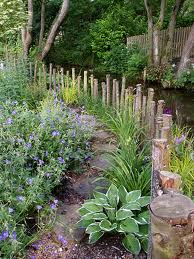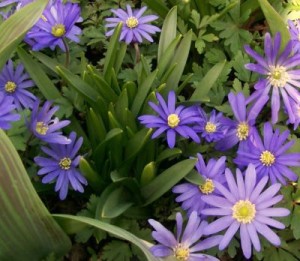





It would be easy to confuse the streamside with the bog garden, for it appears that similar conditions exist, with plants growing beside water. In reality, the conditions beside a stream are almost the complete opposite of those found in a bog garden, so careful consideration must be given to the plants that will be grown and how they will be presented for maximum effect.
 A natural streamside will be extremely difficult to plant successfully, but once this has been achieved, there will be few more beautiful sights. The major problem is the water level, for whereas a bog garden has a consistent and adjustable moisture level, and adjacent bodies of water can be controlled to maintain the ideal conditions, a stream has a will of its own.
A natural streamside will be extremely difficult to plant successfully, but once this has been achieved, there will be few more beautiful sights. The major problem is the water level, for whereas a bog garden has a consistent and adjustable moisture level, and adjacent bodies of water can be controlled to maintain the ideal conditions, a stream has a will of its own.
In winter, particularly after snow melt, a stream is likely to become a raging torrent. Unless securely rooted, any streamside planting may be dislodged, while the banks may suffer scouring and sheet erosion. Of course, the plants will not require too much water in the winter, and in the summer, they will need keeping damp at a time when the stream may be reduced to a trickle.
If an artificial stream is constructed, particularly if made from a liner, it will enable true bog plants to grow on a permanently wet site. The liner should be passed under the area to be planted, allowing the soil to be kept damp. This can also be done with a natural stream, the bed being lined along with the adjacent banks. However, this produces a hazard that is not present when the stream is controlled by a pump, for in a winter surge, great sections of bank may be swept away. Although the plants will stabilize some of the soil, they will not secure it completely, owing to the sandwich effect produced by the liner.
However, where the arrangement does work, this kind of streamside can be magnificent, for it can be developed as an extended bog garden. The plants will prosper in the damp soil, and interesting reflective effects will be created in the stream, provided that it is not flowing too quickly. With a natural streamside that is improved in this way, a certain amount of care must be taken to ensure that the plants do not dry out if there are seasonal variations in the water level. In such a case, leaving the banks without a waterproof membrane may be preferable, particularly if watering will be difficult to arrange.
Where planting takes place directly into the stream bank, care must be taken not to encourage erosion, and also to select plants that will tolerate drier conditions, as well as winter inundation. In such circumstances, species that are usually regarded as border perennials, but that grow better in a bog, should be the first choice. Astilbes, with their plumes of brightly coloured flowers, are most adaptable, so too are the various filipendulas. These might look weary under very dry conditions, but they are tolerant of ordinary moist garden soil and really come into their own when it is wet.
Purple loosestrife (Lythrum salicaria) is a similar proposition, along with its brightly coloured named varieties, while the exotic and easily grown musks, or mimulus, do well in all except the most spartan of conditions, their height and lushness of foliage being related to the amount of moisture that is available to them.
Mix these with various grasses if the going is tough, for the very tolerant Phalaris arundinacea ‘Pieta’ looks almost the same as the moisture-dependent variegated water grass (Glyceria maxima var. variegata). It is easy to cheat by using some of the drought-tolerant stipas instead of rushes. They do not hear close examination, hut the overall effect is similar. The important point to remember is that an effective streamside planting is achieved by the arrangement of flower, foliage and form that grow well. It has nothing to do with doggedly persevering in the cultivation of plants that technically may be streamside plants in nature, but everything to do with producing a convincing picture.
 Streamside planting offers additional opportunities for the skilful garden artist if the unpredictability of soil conditions is used to advantage. Bulbs can be introduced, where they would be impractical in a bog garden. Daffodils, scillas and chionodoxa are all easy-going,will tolerate a wide range of soil conditions, and are not seriously bothered by temporary flooding. Plant them among other perennial streamside plants to create a spring show before the former break into growth. Only the cuckoo flower, or cardamine, is likely to create any unexpected contrasts, while the summer flowering perennials will disguise the fading bulb foliage with their burgeoning leaves.
Streamside planting offers additional opportunities for the skilful garden artist if the unpredictability of soil conditions is used to advantage. Bulbs can be introduced, where they would be impractical in a bog garden. Daffodils, scillas and chionodoxa are all easy-going,will tolerate a wide range of soil conditions, and are not seriously bothered by temporary flooding. Plant them among other perennial streamside plants to create a spring show before the former break into growth. Only the cuckoo flower, or cardamine, is likely to create any unexpected contrasts, while the summer flowering perennials will disguise the fading bulb foliage with their burgeoning leaves.
Of course, a streamside does not have to be cultivated. Some of the most effective features have grass right down to the edge. This may not be easy to mow, and it is inevitable that some grass cuttings will enter the water, which may lead to problems. However, where slopes are carefully adjusted to accommodate a mower, a really classy effect can he created.
Plain grass to the water’s edge can look startling, but remember that this can be highlighted with bulbs, such as the shorter growing, early flowered kinds that die back swiftly and do not produce bulky leaves. The Greek wind-flower (Anemone blanda), with its bright starry blossoms, is superb, as are the bunch-flowered crocuses. These are available in both spring and autumn flowering forms, which will extend the natural streamside season.
Copyright © www.100flowers.win Botanic Garden All Rights Reserved